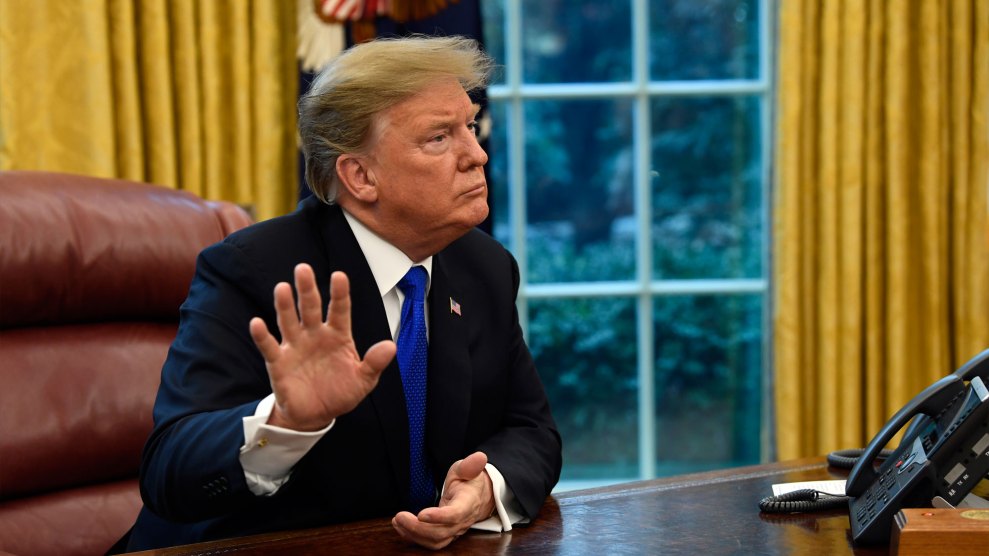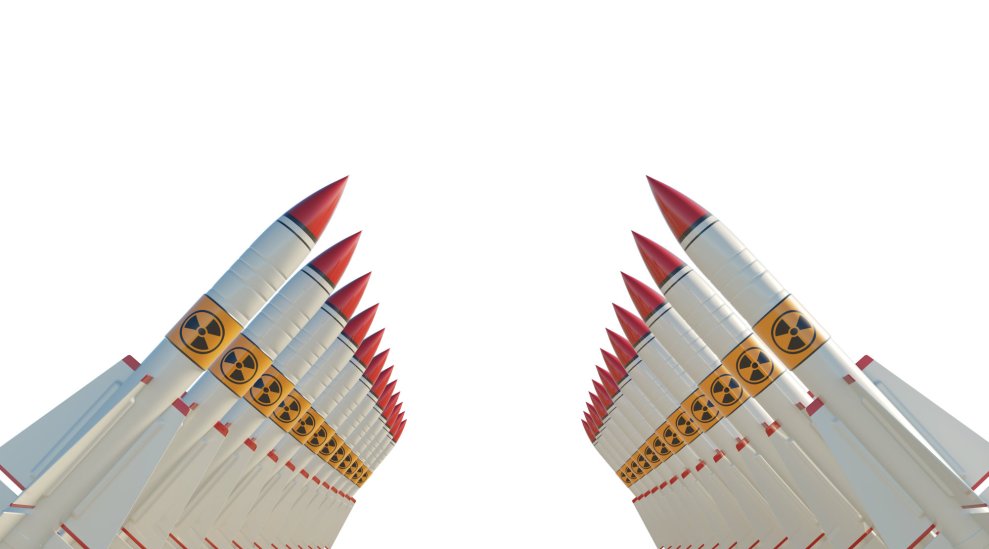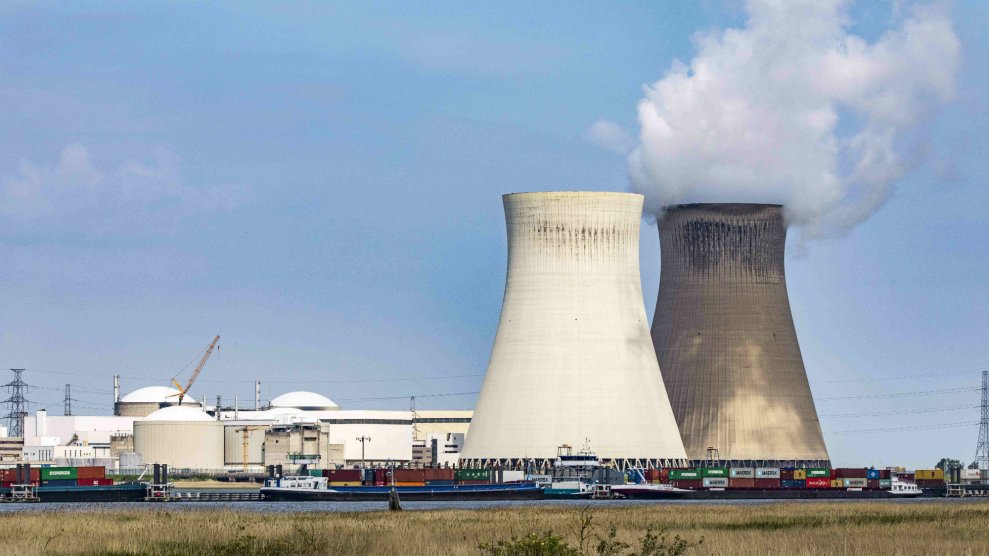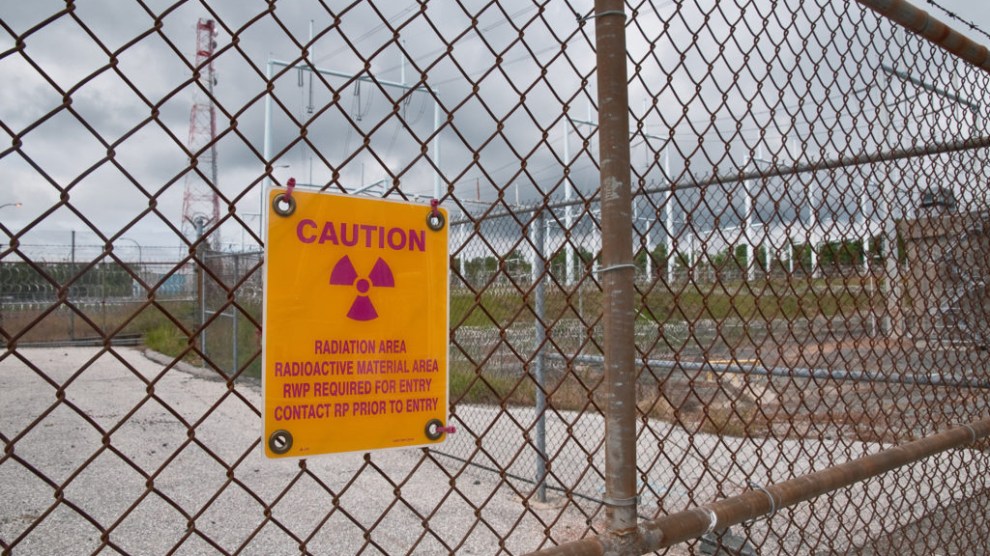
The Nuclear Regulatory Commission is considering formal proposals that would abandon current regulations that require licensees, such as the one pictured here, to keep human exposure to radiation as low as reasonably achievable. Nuclear Regulatory Commission/Creative Commons
This post was originally published by The Center for Public Integrity.
Since World War II, virtually every American business where radiation is present—hospital emergency rooms and cancer wards, uranium mines, nuclear power plants, and others—has operated under rules generally requiring that exposures be kept as low as possible. The rules are based on a widely-accepted scientific dicta that even small amounts of extra radiation can be harmful to human health.
Following those rules, though, is costly and often cumbersome, and so the requirement for low-dose radiation protections—known as the ALARA standard for “as low as reasonably achievable”—has long been annoying to a large swath of American industry. Estimates of the costs associated with these protections run into the billions of dollars.
Until the Trump era, opponents of the rules have gotten little traction in trying to upend low-dose radiation protections—such as isolation units, elaborate shielding, specialized air cleaners, and elaborate worker training—in federal regulations. But proposed relaxations have been percolating in recent months, courtesy of a little-known advocacy group called Scientists for Accurate Radiation Information, or SARI.
Members of the group, which claims its ideas have been wrongly dismissed and belittled by mainstream scientists, subscribe to a minority theory known as “hormesis.” It defies conventional wisdom by holding that damaging things that are dangerous in high doses might actually be beneficial to human health in small doses.
Despite swimming against the tide in the past, one of the group’s members has just been appointed to head a Radiation Advisory Panel at the Environmental Protection Agency, which helps set federal standards for radiation doses received by the public and by workers. And several of its recommendations to ease radiation protections are presently under active consideration by the Nuclear Regulatory Commission.
SARI’s members typically have more day-to-day connections to radiation than others, and potentially more influence: They have held jobs connected to radiation protection at the EPA, the Department of Labor, the Energy Department and its sub-agency responsible for building nuclear weapons at nine factories across the country. Practitioners of nuclear medicine, people employed in the nuclear industry, and professors who teach nuclear medicine or industrial hygiene also populate SARI.
The NRC’s consideration of the SARI views got started when three members of the group petitioned it in 2015 to abandon its current approach and accept that radiation in low doses is not only benign, but improves health. That was two years after SARI’s founding by industry officials trying to tamp down public concerns about the radiation that spilled from the 2011 Fukushima nuclear disaster.
The NRC took the petitions seriously. Its staff created a working group to study the issue, and insiders now say that work is done. According to Scott Burnell, an NRC spokesman, the five members of the commission as a result will take up the issue this spring.
Spokesmen and other NRC sources declined to predict the outcome. But if adopted, the proposed change would provide vast savings for radiation-reliant industries, allowing them to install new medical equipment, deploy new types of nuclear reactors, open or enlarge facilities for making key nuclear weapons components, and continue the clean-up of contaminated nuclear sites without undertaking such expensive precautions to limit radiation exposure to workers, patients and the public.
Pushing hormesis
The commission has had a pro-industry Republican majority since May 2018, when three Trump nominees to it were confirmed. One was Annie Caputo, a former staff member for Republican Sen. James Inhofe (Okla.) that previously worked as a nuclear engineer for the Exelon Corp. a major utility; and the second was David A. Wright, a nuclear industry consultant and retired South Carolina public service commission member. Trump also tapped as the NRC chair Kristine Svinicki, a former Energy Department employee and nuclear engineer well-known for supporting industry as a commission member since 2008. Trump handed her a new five-year term.
This year, these three have already undone a draft rule written during the Obama administration—and hated by industry—requiring new protections at nuclear plants against floods and earthquakes like those at Fukushima. The Jan. 24 vote was a straight party-line 3-2 decision.
Undoing the low-dose radiation protections might be more complicated. Of more than 635 comments collected on the SARI-related low-dose radiation petitions before the NRC closed the record on Nov. 15, only about 100 comments favored any regulatory relaxation.
“If hormesis is incorrect or only applies under certain circumstances, removing the ‘as low as reasonably achievable’ principle could result in a large number of excess cancers,” Olav Christianson, who manages a nuclear medicine practice in Pittsburgh, wrote in a letter to the NRC opposing the proposed regulatory change. “Until we fully understand the health risks, we should continue to employ the most conservative approach.”
But the three main petitioners for a relaxation of radiation protections aren’t gadflies and they haven’t been passive—far from it.
Mark Miller, for instance, is a retired health physicist who spent 23 years at Sandia National Laboratories in Albuquerque, one of the three principal nuclear weapons design centers. His duties there included protecting workers from radiation exposure. In March 2017, Miller sent a copy of the SARI appeal to EPA Administrator Scott Pruitt, “who I was not a fan of,” Miller said, “because of some of his anti-science ideas.” Miller said he thought it was an opportune moment to relax the radiation standards as part of the Trump administration’s broader deregulation push. The following month Pruitt proposed to change EPA regulations to recognize the merits of hormesis.
A second petitioner, Carol Silber Marcus, is a physician specializing in nuclear medicine and a UCLA professor of radiology who once served on the NRC’s Advisory Committee on the Medical Use of Isotopes. Marcus said during a phone interview that she also works as a consultant for lawyers defending clients against radiation overexposure claims and for radiological pharmaceutical companies.
Marcus suggested in a Nov. 6, 2016 article that appeared in the journal Dose Response—a specialty publication created by hormesis supporters as a platform to spread their point of view—that radiation protection professionals, like those who belong to SARI, should purposely defy existing regulations.
“What if large numbers of licensees went on an ALARA strike?” Marcus wrote. “If large numbers of licensees do this, it would be hard for the NRC to fight it. The NRC would look ridiculous, as it should.” In an April 30, 2018, letter to NRC regulators last year she made clear her disdain for their meddling in nuclear medicine: “We do not need näive dilletantes at the NRC deciding what Nuclear Medicine physicians need to learn.”
When she’s teaching physicians in residence at UCLA, “I sneak in some stuff on low-dose radiobiology and explain to them that the government is lying to you,” Marcus said in a phone interview.
Mohan Doss, the third SARI member petitioning the NRC, is a medical physicist and professor at the Fox Chase Cancer Center in Philadelphia. Doss contends the benefits of low-level radiation are well established, but he concedes that many scientists disagree. “There’s plenty of evidence that shows cancer risk goes down after people receive exposures to low levels of radiation,” he asserted. He adds that “if radiation exposure standards were relaxed,” it would produce important savings for the nuclear power industry and for medical uses of radiation.
Like many of his colleagues in SARI, Doss says that exposure to a small amount of radiation causes a small amount of cellular damage, but asserts this triggers the body’s cells to repair themselves and enhances the immune system, and thus fuels better overall health through heightened resistance to illnesses, including cancer. He says he also rejects the idea that children and fetuses have any special vulnerability to lasting harm from low-level radiation exposures because their defenses are also enhanced with the exposures.
These assertions stand scientific consensus on its head. Most experts say to the contrary that even low doses of radiation cause cell damage that years later can promote uncontrolled cell growth and replication, and that children and fetuses are particularly susceptible to harm. That seven-decade-old view was reaffirmed as recently as last April in a study by a congressionally chartered nonprofit organization, the National Council on Radiation Protection and Measurement.
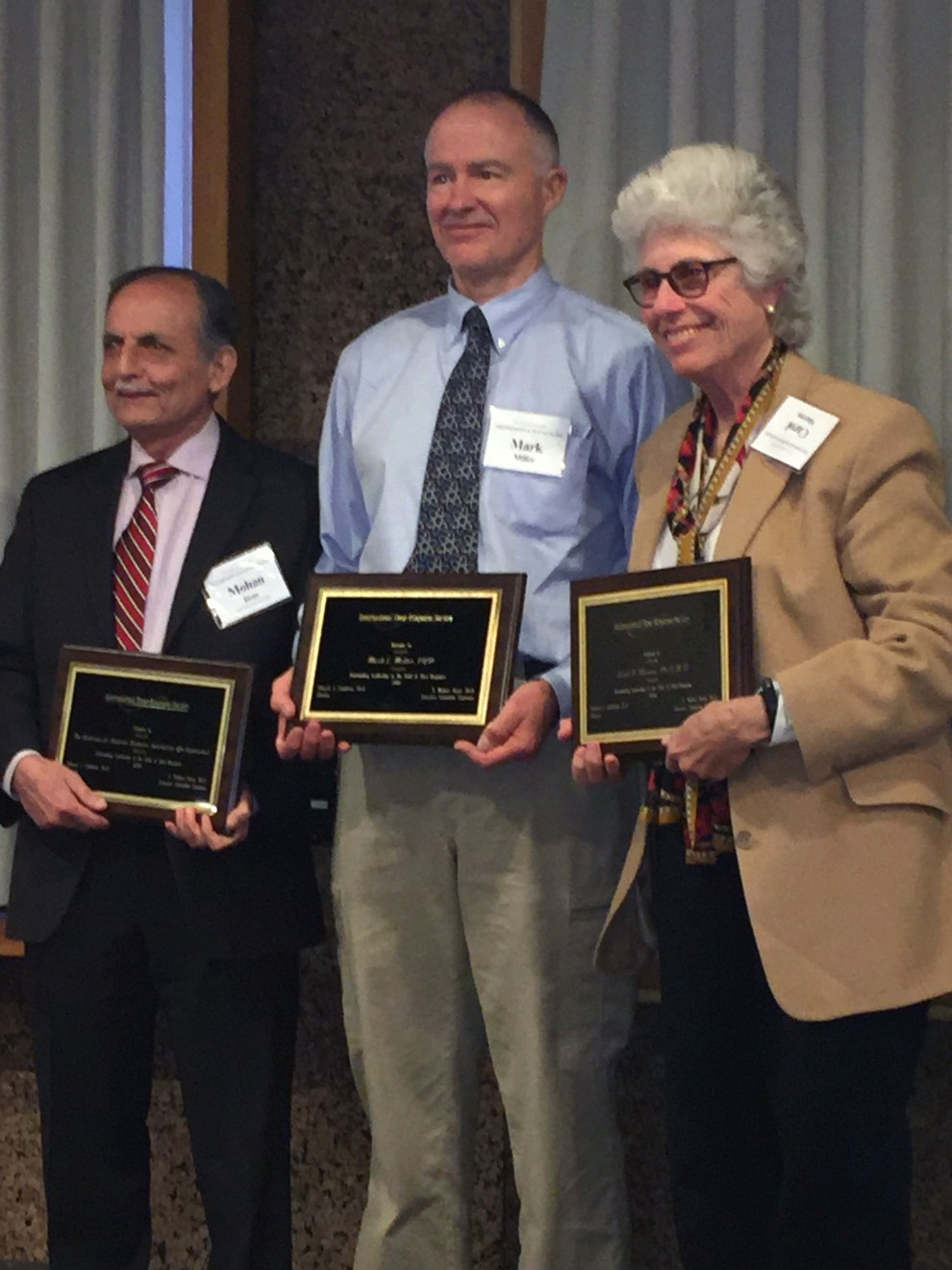
Petitioners (left to right) Mohan Doss, Mark Miller and Carol Marcus are honored by the International Dose-Response Society for hormesis with leadership awards in 2016.
Rio Grande Chapter of the Health Physics Society
The study, overseen by a dozen experts from the government, academia, and industry, and funded by the NRC, considered 29 contemporary scientific studies of the effects of low-dose radiation in reaffirming that even low-level radiation should be avoided to the extent possible.
“There is clear evidence of excess risks for many cancer types, such as bladder, breast, colon, stomach and lung,” from exposure to excess radiation, the report said. It acknowledged that at lower doses the relationship is less certain, but noted that several long studies of medical outcomes for tuberculosis patients given x-ray imaging known as fluoroscopy collectively showed “a straight-line relationship between breast tissue [radiation] dose and breast cancer, adding substantial weight to the judgment on the use of the [existing] model for radiation protection.”
It added that “there was no conclusive evidence” to refute the linear, or direct cause and effect, “relationship for many of the risks attributable to low-level ionizing radiation”—essentially endorsing the mainstream insistence on low-dose protections as a prudent, cautionary measure. The NRC members will consider the report as they deliberate about the SARI members’ petition, McIntyre said.
The 2018 report didn’t quiet the debate, however, in part because hormesis advocates have found numerous friends in the deregulation-oriented Trump administration. During the six months that followed the radiation protection council’s unambiguous endorsement of the current standards, initiatives to relax human radiation protection standards made some sudden and striking inroads.
EPA’s proposal to roll back radiation regulation to save industry from compliance costs was the subject of a hearing last October organized by House Republicans. The hearing featured testimony from longtime hormesis supporter Edward Calabrese, a professor of toxicology at the University of Massachusetts—Amherst, who has long allied himself with industries seeking to ease government regulations. A center he runs has been funded by the tobacco firm R.J. Reynolds, the chemical firm Dow-Corning, the oil firm ExxonMobil, and utility companies. He’s also the founder of the Dose Response journal that advocates for hormesis, and the sponsor of an annual conference about the theory.
Pruitt’s departure under an ethical cloud caused the EPA to put the proposal on a back-burner, but scientists and government personnel who’ve closely monitored the initiative say it’s scheduled to get renewed consideration in 2020. Meanwhile, a bill aimed at the same sort of regulatory rollback passed the House of Representatives in March 2017. Companion legislation was also introduced in the Senate, but the concept will likely face tough sledding now that the House has been taken over by Democrats.
Janet McCabe, an environmental lawyer who headed the EPA division responsible for radiation and air pollution protection during the Obama administration, compared hormesis supporters to climate change deniers whose interests are well positioned to benefit from the Trump administration’s industry-oriented deregulation campaign. McCabe said she was not surprised to see “this more fringe view getting an audience with this administration.”
But a closer look at the SARI membership list makes clear that its adherents have held important government jobs, often related to radiation controls, for decades.
SARI member Brant Ulsh, for example, is a veteran of the National Institute on Occupational Safety and Health, a federal agency, where he prepared dose calculations for nuclear weapons site workers. Since 2012, he’s worked at Cincinnati-based M. H. Chew and Associates, which provides advice to radiation-related industries, including Lawrence Livermore National Laboratory in northern California, one of the nation’s three nuclear weapon design centers, and a program based at Oak Ridge National Laboratory in Tennessee that performs radiation dose reconstructions for worker exposure incidents.
In January, Ulsh was appointed by Pruitt’s successor as EPA administrator, former coal lobbyist Andrew Wheeler, to chair the agency’s radiation advisory board and help set future national exposure standards. His ideas will reach sympathetic ears at EPA, where since 2005, SARI member John Cardarelli II has been the scientific and technical leader of the agency’s program to detect airborne radiation and assess its consequences.
Last summer, Ulsh and Cardarelli coauthored a Dose Response article urging the EPA to adopt a hormesis-based approach. They said the current regulatory standard for radiation exposure unnecessarily complicates cleanup of sites that have been contaminated by past nuclear weapons-related work. “The impact to the United States is real, resulting in enormous cleanup costs that show no demonstrable benefit to society,” they wrote. Neither responded to email and phone messages seeking an interview.
Daniel O. Hirsch, an activist on radiation issues and former director of the University of California-Santa Cruz’s program on environmental and nuclear policy, said he was startled to learn that that “people who have an agenda of increasing the public’s exposure to radiation are now being placed in significant positions of power.” Those who say “radiation is good for you are placing people in danger,” Hirsch said.
Three other listed SARI members have similarly had important radiation protection responsibilities. Frank Crawford is a health physicist in the Labor Department’s Office of Worker Compensation Programs, which decides what role radiation exposure played in nuclear weapon workers’ health problems, and whether they or their heirs should receive compensation.
Rex Borders was responsible for cataloging and analyzing radiation releases at nuclear weapons labs and plants around the country, on behalf of the Department of Energy’s National Nuclear Security Administration until his retirement in March 2017. In a phone interview, he said he has not remained active in SARI since retiring. And Richard Hansen, according to the SARI website, works for the contractor that operates the Nevada National Security Site. Published reports he has written about how the public and the government should respond to attacks involving radioactive materials, such as an improvised “dirty bomb,” identify him as a counterterrorism expert.
Crawford, who speaks regularly about historical radiation contamination incidents at meeting halls crammed with cancer-stricken nuclear weapon workers and widows in cities like Oak Ridge, Tennessee, and Los Alamos, New Mexico. Attempts to reach Hansen and Crawford by phone, email and through their listed employers were unsuccessful.
SARI’s minority scientific view that the exposure to low doses of radiation can promote better health—instead of helping cause cancer—even was also approved for presentation in 2016 to personnel responsible for worker safety at Los Alamos National Laboratory, a government facility famous for creating the first U.S. nuclear explosives as well as for a series of deaths and injuries stemming from radiation-related accidents. The Center for Public Integrity revealed in 2017 that poor safety practices and inadequate staffing there forced a shutdown of America’s only facility for production of plutonium pits for nuclear arms from 2013 to 2017.
“Low levels of radiation are not harmful to human life and, in fact, humans require additional exposure to ionizing radiation in order to achieve optimum health via a process known as Radiation Hormesis,” the laboratory’s presentation, entitled “(Mis)Understanding Radiation,” stated. The presentation argued that that “incidence of cancer and other illness is reduced when one is exposed to low levels of radiation.” It said that unwarranted fear of radiation is unnecessarily holding back nuclear energy development and further medical advancements that rely on radioactive materials.
The presentation was published on-line and given in person to the laboratory’s worker safety and security team, according to lab spokesman Kevin Roark. It was written several weeks after the McClatchy newspaper chain published a series documenting how more than 30,000 nuclear weapons workers had died from cancer caused on the job.
In a section of the Los Alamos presentation discussing a law established in 2000 to compensate employees of the Department of Energy’s nuclear weapon complex for cancer associated with workplace radiation exposure, the lab authors undiplomatically used this blunt bullet point first: “Everybody dies of something, eventually.”
“I was horrified when I read that,” particularly on the letterhead of a Department of Energy-sponsored laboratory where some of the dead and sickened workers were employed, said Terrie Barrie, an advocate in Colorado who assists weapon workers in their pursuit of health-related benefits. “For the current workers, it has to raise questions about whether they’re taking care of the workers the way they should be.”
